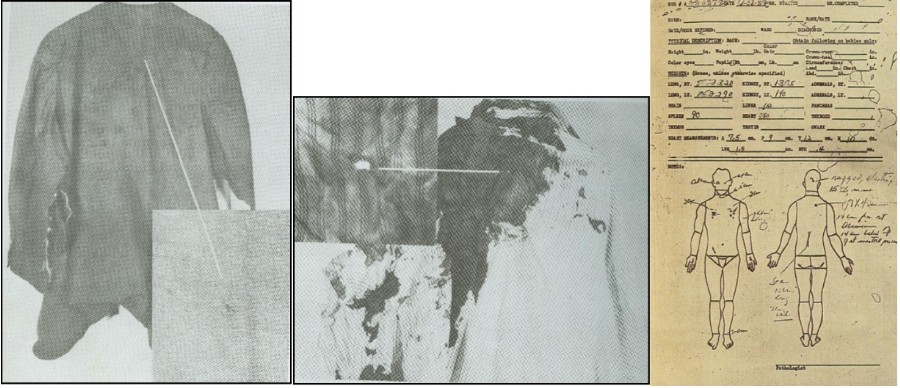George Jefferies' recently released film of President and Mrs. Kennedy on Main Street in Dallas taken less than 90 seconds before the assassination has caused some debate due to the bunching of JFK's jacket seen in the footage. In order to support an Oswald lone gunman scenario, the Warren Commission determined the location of the bullet entrance in JFK's back was near the base of the neck. This entrance location would allow the bullet to pass through the neck and out the front of the throat in order to continue on to account for the wounds in Governor Connally. Critics of the Warren Commission's findings have always argued that there was no physical evidence to support this entrance location near the back of the neck and pointed out the bullet holes in the back on JFK's suit and shirt were located further down in the back. Defenders of the Commission's findings have always countered that JFK's suit had bunched up, which accounted for a higher wound in the body despite a lower hole in the suit jacket.
Let's look at the facts and evidence. What is the physical evidence to determine the entrance wound to JFK's back?

- FBI Exhibit 59, JFK's suit coat, measures the bullet hole in the jacket to be 5 3/8 inches below the top of the collar, and appears to be directly in the middle of the back.
- FBI Exhibit 60, JFK's shirt, measures the bullet hole in the shirt is 5 3/4 from top of collar and about 3/4 inch from center.
- Autopsy drawings of President Kennedy conducted by Dr. Humes, shows a bullet hole in JFK's back that would match the location of the hole in his clothing. Hole is in the middle of back approximately 6 inches down from the neck.
- Autopsy photograph of Kennedy's body shows a bullet hole in Kennedy's back clearly away from base of neck and matching the location of hole in shirt.
- The Jefferies film does show some slight bunching of JFK's jacket. It is taken on Main Street. Photographs showing JFK on Houston and Elm Street do show a slight crease in the jacket, but no significant bunching.
- I have personally conducted several experiments with individuals of JFK's height and weight (approximately 6 feet and 195 pounds) to determine if waving, moving around, raising shoulders could elevate one's jacket and shirt to align with an entrance wound near the base of the neck on the right side. Specifically, one is talking about the fabric elevating up 2 3/4 inches and moving to the right 1 3/4 inches. I have never been able to come even close to the necessary bunching necessary to produce an entrance wound necessary to support the lone nut hypothesis. I would strongly encourage skeptics to place a mark on the back of a shirt and conduct their own experiments. Seeing is believing.
- The shirt has very little movement. It is buttoned to the neck and tucked into the pants. Even if you unbutton the shirt at the neck area and have someone pull the shirt up, the armpit area prevents any significant movement. Even loose fitting shirts could not come close to producing the Commission's determination.
- The Jefferies film does show JFK's suit jacket had a tailored fit in that it is snug around the shoulders, arms, and armpit areas. All of this would limit the suit's upward movement.
- The amount of bunching of the suit coat in the Jefferies film is not significant enough to raise the entrance wounds to the base of the neck. It is an experiment that can easily be done. Not only was the upward movement impossible, the fabric twisting or shifting to the right by almost two inches was also impossible.
- Given the overwhelming physical evidence of FBI exhibits and autopsy drawing and photographs that show the entrance wound to JFK's back approximately five inches from the neckline and in the middle of the back, and no other credible evidence to suggest otherwise, it is therefore only reasonable to conclude the entrance wound bullet to the back could not exit JFK's neck. Without the "magic bullet theory" the lone nut hypothesis fall apart.


